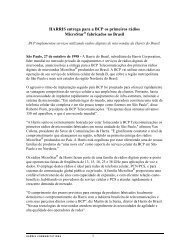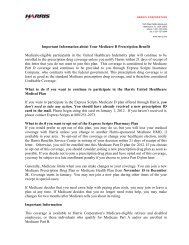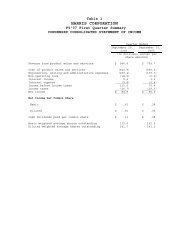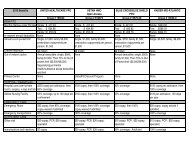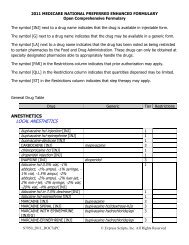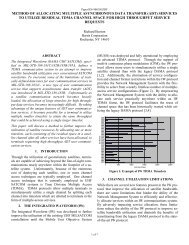harris corporation
harris corporation
harris corporation
Create successful ePaper yourself
Turn your PDF publications into a flip-book with our unique Google optimized e-Paper software.
demands on our judgment, with financial reporting results dependent upon estimates about the effect of matters that<br />
are inherently uncertain and may change in subsequent periods. Specific risks for these critical accounting estimates<br />
are described in the following paragraphs. The impact and any associated risks related to these estimates on our<br />
business operations are discussed throughout this MD&A where such estimates affect our reported and expected<br />
financial results. Senior management has discussed the development and selection of the critical accounting policies<br />
and estimates and the related disclosure included herein with the Audit Committee of our Board of Directors.<br />
Preparation of this Report requires us to make estimates and assumptions that affect the reported amount of assets<br />
and liabilities, disclosure of contingent assets and liabilities at the date of our financial statements and the reported<br />
amounts of revenue and expenses during the reporting period. Actual results may differ from those estimates.<br />
Besides estimates that meet the “critical” accounting estimate criteria, we make many other accounting<br />
estimates in preparing our financial statements and related disclosures. All estimates, whether or not deemed critical,<br />
affect reported amounts of assets, liabilities, revenue and expenses as well as disclosures of contingent assets and<br />
liabilities. Estimates are based on experience and other information available prior to the issuance of the financial<br />
statements. Materially different results can occur as circumstances change and additional information becomes<br />
known, including for estimates that we do not deem “critical.”<br />
Revenue Recognition on Development and Production Contracts and Contract Estimates<br />
A significant portion of our business is derived from development and production contracts. Revenue related to<br />
development and production contracts is recorded using the percentage-of-completion method generally measured by<br />
the costs incurred on each contract to date against estimated total contract costs at completion (“cost-to-cost”) with<br />
consideration given for risk of performance and estimated profit. Revenue in our Government Communications<br />
Systems segment primarily relates to development and production contracts and the percentage-of-completion<br />
method of revenue recognition is primarily used for these contracts. Amounts representing development and<br />
production contract change orders, claims or other items that may change the scope of a development and<br />
production contract are included in revenue only when they can be reliably estimated and realization is probable.<br />
Incentives or penalties and award fees applicable to performance on development and production contracts are<br />
considered in estimating sales and profit rates, and are recorded when there is sufficient information to assess<br />
anticipated contract performance. Incentive provisions, which increase earnings based solely on a single significant<br />
event, are generally not recognized until the event occurs. Our development and production contracts are generally<br />
not segmented. If development and production contracts are segmented, we have determined that they meet the<br />
segmenting criteria outlined in the accounting standard for construction-type and production-type contracts.<br />
Under the percentage-of-completion method of accounting, a single estimated total profit margin is used to<br />
recognize profit for each development and production contract over its entire period of performance. Recognition of<br />
profit on development and production fixed-price contracts requires estimates of: the contract value or total contract<br />
revenue, the total cost at completion and the measurement of progress toward completion. The estimated profit or<br />
loss on a development and production contract is equal to the difference between the estimated contract value and<br />
the estimated total cost at completion. Due to the long-term nature of many of our programs, developing the<br />
estimated total cost at completion often requires significant judgment. Factors that must be considered in estimating<br />
the work to be completed include labor productivity and availability of labor, the nature and complexity of the work<br />
to be performed, availability and cost of materials, subcontractor performance, the impact of delayed performance,<br />
availability and timing of funding from the customer and the recoverability of claims outside the original<br />
development and production contract included in the estimate to complete. We review cost performance and<br />
estimates to complete on our ongoing development and production contracts at least quarterly and, in many cases,<br />
more frequently. If a change in estimated cost to complete a development and production contract is determined to<br />
have an impact on contract earnings, we will record a positive or negative adjustment to estimated earnings when<br />
identified. Revenue and profits on a cost-reimbursable development and production contract are recognized when<br />
allowable costs are incurred in an amount equal to the allowable costs plus the profit on those costs. These profits<br />
may be at a fixed or variable percentage of allowable costs, depending on the contract fee arrangement. Thus, costreimbursable<br />
development and production contracts generally are not subject to the same estimation risks that affect<br />
fixed-price development and production contracts. We have not made any material changes in the methodologies<br />
used to recognize revenue on development and production contracts or to estimate our costs related to development<br />
and production contracts in the past three fiscal years.<br />
As of July 1, 2011, the amount of unbilled costs and accrued earnings on fixed-price development and<br />
production contracts classified as “Inventory” in our Consolidated Balance Sheet was $381.0 million compared with<br />
$295.3 million as of July 2, 2010. These amounts include gross costs and accrued income, which is netted against<br />
billings and progress payments. A significant change in an estimate on one or more programs could have a material<br />
53




